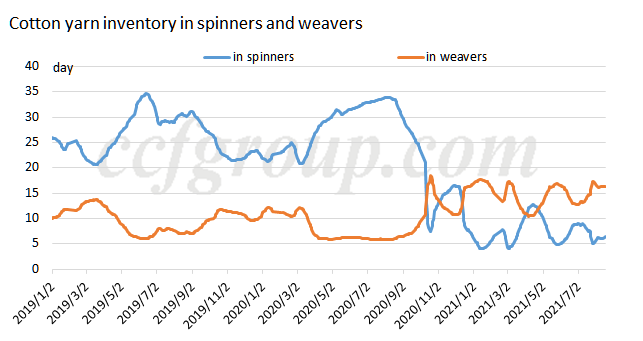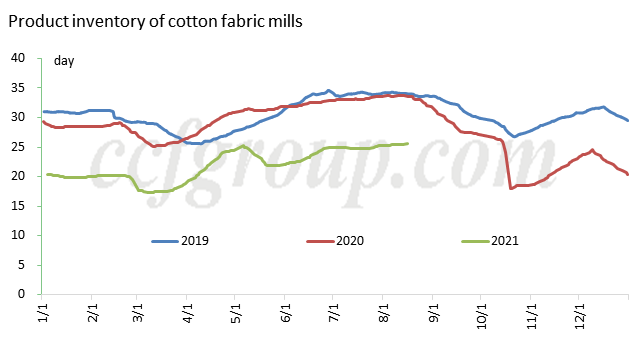How long will the rise of cotton yarn last?
ZCE cotton futures climbed up and broke through prior high after falling back in the end of Jul. Jan contracts once moved up to 18,500yuan/mt at the highest, nearly 1000yuan/mt higher from the low in early Aug. Cotton yarn paled facing the hot cotton. The offers of cotton yarn mills have increased by 500-1000yuan/mt, but they are hardly accepted by downstream buyers. The reason lies in the inconsistent anticipations of upstream and downstream in a sign that big differences exist in the fundamentals between cotton and cotton fabric which embarrasses the intermediate link cotton yarn.
From the perspective of cotton, production reduction of new cotton and rush procurement of seed cotton seem to be inevitable and this anticipation generally recognized on the market boosts cotton price. Most players expect the price of new seed cotton over 8yuan/kg, even 10yuan/mt, about 24,000yuan/mt conversed into lint cotton price. Even if the specific price level is hard to tell, the ginners are highly possible to procure seed cotton in a rush and push up cotton price. CCFGroup also holds the bullish attitude to cotton price before Oct.
However, downstream buyers do not accept it all. Why?
1. They stock up a certain raw materials in advance amid the vigorous sentiment.

With the upward anticipation of new cotton and expected demand in Golden Sep and Silver Oct, the enterprises with adequate capital have stocked up a certain raw materials for fear of insufficient cheap raw materials when orders come. From the chart above, it can be seen that cotton yarn inventory in spinners remains low for long, while that in weavers pins at two years’high. Meanwhile, more inventory is transferred to traders which is absolutely high in recent years. In addition, the restocking of cotton fabric for speculation is also proceeding. The inventory of grey fabric in traders and dyeing plants also stays high. However, after all parties have prepared well, they may be tired when the opportunities really come, let alone the opportunities have not come now.
2. Under the pandemic, downstream demand is expected to reduce and weavers still hold high product inventory.

Recently, the pandemic resurges in and outside China, making a dent in the anticipation for golden Sep and silver Oct. Cotton fabric inventory has reached the high since last Oct, indicating stagnant digestion in downstream. Export orders are heard to improve recently, but high prices resulting in no orders is also heard. In addition, weavers have reduced run rate, especially in Guangdong. The expected low demand leads to less enthusiasm of market players to chase up the high prices.
As things stand, cotton is likely to upsurge, which may drive cotton yarn to increase, but it still depends on downstream demand. Currently, most players predict cotton yarn price to improve first and fall back then, and the fall will be seen after new cotton comes to the market. Firstly, the demand will reduce after Oct due to the slack season. Secondly, the high price will restrain the demand, especially export sales. Thirdly, cotton yarn price is possible to fall back after the lint comes to the market. In addition, cotton yarn market is expected to be weak in 2022. Under this expectation, some traders and spinners with higher inventory may sell in advance and lower prices when they find the demand is not as good as expected. At the same time, downstream will not follow up. On the other hand, if the demand in peak season performs well, cotton yarn price will smoothly move up amid low inventory.
In general, cotton yarn price will further improve in short term, but it may not be very smooth as previous rises. Market players still have concerns about the demand in peak season and bearish expectation to later market exists. As a consequence, buyers chasing up high prices will reduce and the price spread between cotton and cotton yarn is likely to shrink. They may prefer to observe actual downstream demand.
- Top keywords
- Cotton Price
- Cotton Futures Price
- Cotton Futures
- CZCE
- PTA Futures Price
- Chemical Fiber
- Polyester Prices
- Wool price
- PTA Futures
- Shengze Silk
- China
- Yarn Price
- price
- China Textile City
- Fibre Price
- Benzene Price
- Cotton
- Index
- Cotton Index
- PTA
- fabric price
- NYMEX
- Top 10
- textile industry
- Spot Cotton
- Cotton Yarn
- Polyester Price
- Futures
- PTA Price
- cotton yarn price

